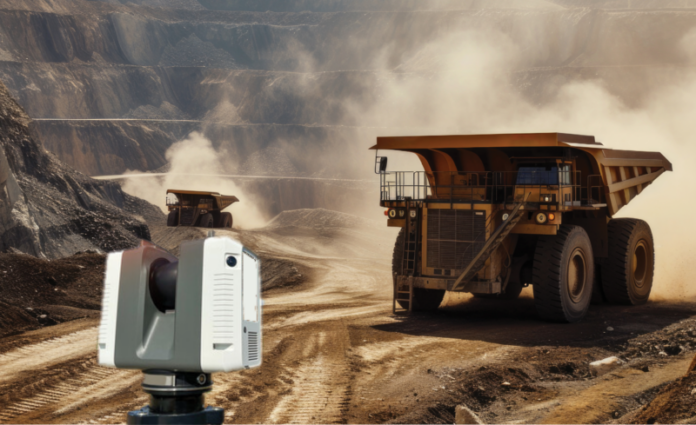The need for increased efficiency, enhanced safety and improved resource management in the mining industry is driven by a significant transformation to optimize its processes and maximize its profitability.

Elton du Plessis, Senior Technical Lead – MineMeasurement at Maptek states that, “In today’s industry, safety, efficiency, and accuracy of data are vital for the successful operation of any mining project. Consequently, 3D laser scanners have become an invaluable tool in day-to-day site operations.”
For any mining company looking to optimize its processes and maximize its profitability, 3D laser scanners offer a wealth of benefits, impacting various aspects of operations from exploration and planning to extraction and post-mining rehabilitation.
According to du Plessis, Laser scanning enables a highly precise method of capturing topographical and structural site data—crucial for informing decisions across every stage of the mining cycle. The high level of accuracy that 3D laser scanner provide enables mining teams to better assess the stability of complex structures such as rock faces.”
“Through continuous monitoring of conditions,” He continues, “engineers can identify potential issues related to structural instability or equipment wear, before they escalate. This proactive approach to safety helps prevent costly downtime, leading to more secure operations.”
But how exactly does this technology benefit your mining operations?
Enhanced Site Modeling and Planning
Before any excavation begins, accurate and detailed site modeling is important. 3D laser scanners for mining, capture millions of points of data per scan, creating incredibly detailed point clouds that form the basis for highly accurate 3D models of the mine site, including topography, structures, and existing infrastructure.
“High-quality image acquisition allows survey teams to be confident that accurate, current topographic and volumetric data is guiding mine planning and production. The result is more effective resource management—leading to higher productivity and a more streamlined operation,” says du Plessis.
This detailed digital model surpasses traditional methods in several key aspects:
Precision and Accuracy: Manual surveying methods, while valuable, are prone to human error and limitations in accessibility. A 3D laser scanner, however, provides incredibly accurate measurements, resulting in more precise mine design and planning. This minimizes potential over- or under-estimation of resources, leading to better optimization of extraction processes.
Comprehensive and Faster Data Acquisition: The scanner captures data across a wide area rapidly, generating a complete and holistic picture of the site. This panoramic view allows for a better understanding of the geological formations, potential hazards, and optimal placement of infrastructure.
This comprehensive data set allows for more informed decisions regarding mine layout, road design, and waste management strategies. Additionally, 3D laser scanning significantly reduces the time required for data acquisition. This speed translates to faster project timelines and quicker return on investment. You can get a complete digital twin of your site in a fraction of the time it would take using conventional techniques.
Improved Safety and Risk Management
Mine safety is paramount, and 3D laser scanning plays a crucial role in mitigating risks. The technology enables:
Hazard Identification and Assessment: The detailed point cloud data allows for thorough identification of potential hazards such as unstable slopes, rockfalls and underground voids. Early detection of these hazards allows for proactive mitigation strategies, reducing the risk of accidents and improving worker safety.
Improved Site Monitoring and Emergency Response: Regular scanning of the mine site reveals changes in topography, helping identify potential instability or subsidence. This enables timely interventions, reducing the risk of catastrophic events. Contrariwise, a precise 3D model of the mine site is invaluable during emergencies. First responders can use this model to navigate the area effectively, optimizing rescue operations and minimizing response time.
Optimized Resource Management and Extraction
Efficient resource extraction is crucial for profitability. A 3D laser scanner assists in:
Accurate Volume Calculations: Determining the accurate volume of ore and waste is vital for efficient mining operations. 3D laser scanning provides precise volume calculations, minimizing waste and optimizing resource extraction. This improves overall efficiency and minimizes unnecessary mining activity.
Improved Blast Design and Management: By understanding the precise geometry of the rock mass, you can design more effective blasting patterns. This leads to better fragmentation, reduced overbreak and underbreak and improved overall efficiency in the extraction process. Besides, the technology can rapidly and accurately measure stockpiles of ore and waste, providing real-time inventory data for efficient management of materials.
Streamlined Construction and Infrastructure Development
The benefits of 3D laser scanning extend to the construction and development of infrastructure within the mine site:
Precise Construction Monitoring: Regular scanning allows for accurate monitoring of construction progress, ensuring that structures are built to specifications. This minimizes delays and ensures the timely completion of projects.
As-Built Documentation: Generating ‘as-built’ models of completed infrastructure is essential for maintenance and future planning. 3D laser scanning provides accurate and comprehensive as-built documentation, reducing ambiguity and improving communication between different project stakeholders.
Integration with Other Technologies
The power of 3D laser scanning is further amplified when integrated with other technologies within a digital mining environment. For example, integrating this data with GIS systems, mine planning software and drone imagery provides a comprehensive, integrated view of the mine operation.
As du Plessis concludes, “By utilising laser scanning technology, mining companies can ensure that they not only plan mine development with greater accuracy but enhance the overall efficiency and profitability of their projects.”



